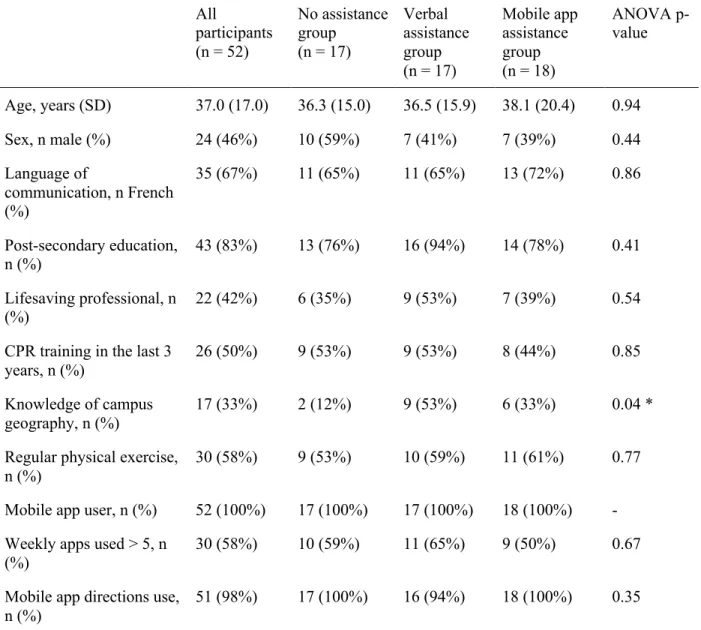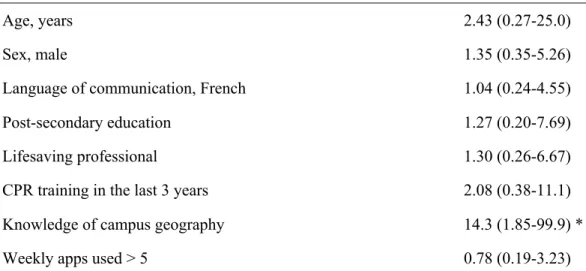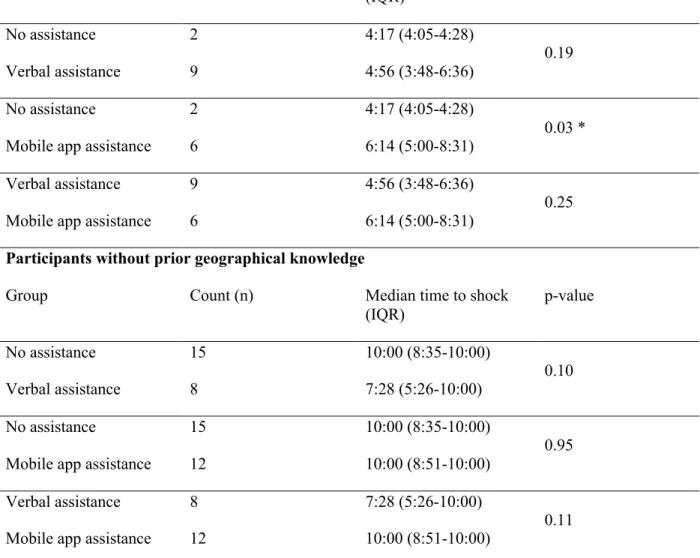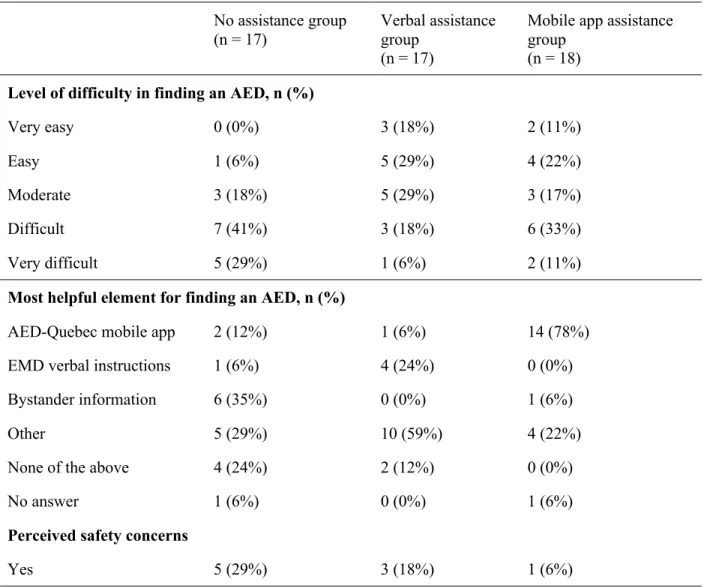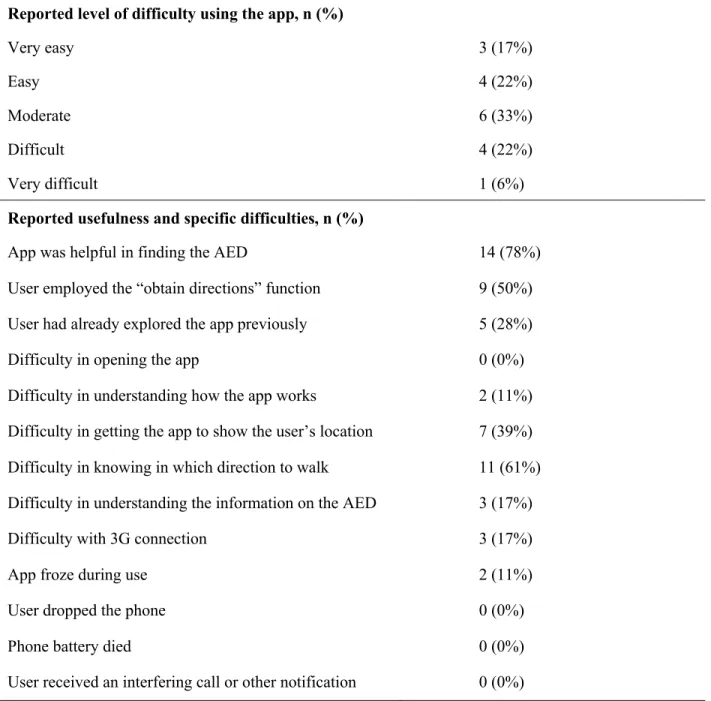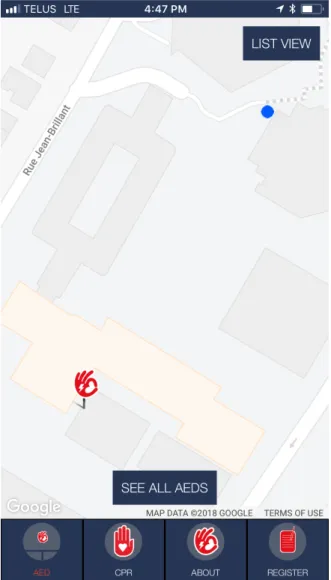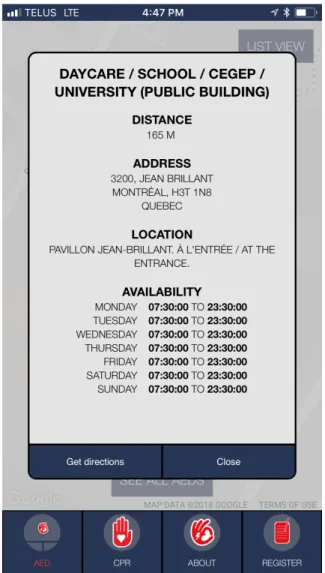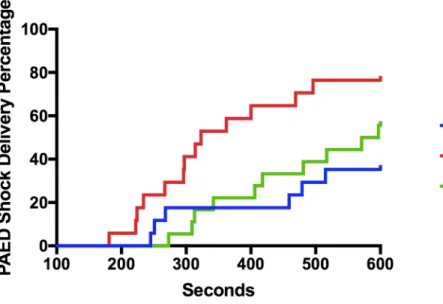simulation (AED G-MAP)
Joel Neves Briard MD
1, Frédéric Grou-Boileau
2, Alaa El Bashtaly BScN
1, Catherine Spenard
2,
François de Champlain MD FRCPC
2,3, Valérie Homier MD MSc FRCPC
2,3This is an Accepted Manuscript of an article published by Taylor & Francis in Prehospital
Emergency Care on 10 September 2018, available online at :
https://www.tandfonline.com/doi/full/10.1080/10903127.2018.1511017
Submitted: 27 May 2018. Accepted: 7 August 2018.
Affiliations :
1. Faculty of Medicine, Université de Montréal, Montreal, Canada
2. Faculty of Medicine, McGill University, Montreal, Canada
3. Department of Emergency Medicine, McGill University Health Centre, Montreal, Canada
Citation: Neves Briard J, Grou-Boileau F, El Bashtaly A, Spenard C, de Champlain F, Homier
V. Automated external defibrillator geolocalization with a mobile application, verbal assistance
or no assistance: A pilot randomized simulation. Prehosp Emerg Care. 2018 (Article In Press)
Short Title: The AED G-MAP Simulation
Abstract (words): 318
Text (words): 4301
Figures: 2
Tables: 5
Corresponding author information:
Valérie Homier MD MSc FRCPC
Department of Emergency Medicine
McGill University Health Centre
1001 Decarie Boulevard, Room CS1.6216
Montreal, Canada, H4A 3J1
Abstract
Background: Shockable rythms are common among victims of witnessed public out-of-hospital cardiac arrest (OHCA), but bystander defibrillation with a public automated external defibrillator (PAED) is rare. Instructions from the emergency medical dispatcher and mobile applications were developed to expedite the localization of PAEDs, but their effectiveness has not been compared.
Methods: Participants were enrolled in a three-armed randomized simulation where they witnessed a simulated OHCA on a university campus, were instructed to locate a PAED and provide defibrillation. Participants were stratified and randomized to: (1) no assistance in finding the PAED, (2) assistance from a geolocalization mobile application (AED-Quebec), or (3) verbal assistance. Data collectors tracked each participant’s time elapsed and distance traveled to shock.
Results: Of the 52 volunteers participating in the study (46% male, mean age 37), 17 were randomized to the no assistance group, 18 to the mobile application group and 17 to the verbal group. Median (IQR) time to shock was respectively 10:00 min (7:49-10:00), 9:44 (6:30-10:00), and 5:23 (4:11-9:08), with statistically significant differences between the verbal group and the other groups (p≤0.01). The success rate for defibrillation in <10 minutes was 35%, 56% and 76%. Multivariate regression of all participants pooled showed that knowledge of campus geography was the strongest predictor of shock in < 10 minutes (aOR = 14.3, 95% CI: 1.85-99.9). Among participants without prior geographical knowledge, verbal assistance provided a trend towards decreased time to shock, but the differences over no assistance (7:28 vs 10:00, p=0.10) and over the mobile app (7:28 vs 10:00, p=0.11) were not statistically significant.
Conclusion: In a simulated environment, verbally providing OHCA bystanders with the nearest public AED’s location appeared to be effective in reducing the time to defibrillation in comparison to no assistance and to an AED geolocalizing mobile app, but further research is required to confirm this hypothesis, ascertain the external validity of these results and evaluate the real-life implications of these strategies. Keywords: cardiac arrest; automated external defibrillator; emergency medical services, mobile app, emergency medical dispatcher
Introduction
In Canada, up to 85% of 45,000 annual cardiac arrests occur at home or in public spaces and at most 10% of patients survive to hospital discharge (1-3). Prompt prehospital defibrillation by the earliest available responder, whether emergency medical services (EMS) or a bystander witness, is a time-sensitive key element in terminating underlying malignant tachyarrhythmia and achieving survival (4-8).
Shockable rythms are initially found in up to 60% of out-of-hospital cardiac arrests (OHCA) occuring in a public space (9, 10). Survival to hospital discharge and good neurological functional outcome are significantly improved among such victims receiving bystander shock preceeding the arrival of EMS (4, 7, 11-13). Worldwide, automated external defibrillators (AEDs) are increasingly available in public spaces due to public and private efforts (14-16). However, bystander shock using a public automated external defibrillator (PAED) only precedes EMS arrival in 3-6% of OHCA in Canada (17, 18). Among multiple factors limiting PAED use, the lack of knowledge regarding the location of nearby AEDs is speculated to be a chief limitation (19).
In response to low PAED utilization, communities have developed strategies to assist OHCA bystanders in locating these life-saving devices, notably through verbal assistance from the emergency medical dispatcher (EMD) and through innovative mobile phone applications (“mobile apps”). These strategies have shown promise in recent initial studies (20-22), but their efficacy has not been evaluated in a comparative randomized simulation.
Methods
Study Design
This research project was a three-armed, open, controlled randomized simulation. Participants consecutively took part in a walk on a university campus during which they were unexpectedly solicited by nearby witnesses of a simulated OHCA and asked to locate and employ a PAED. As detailed below,
participants either obtained no assistance in finding the PAED, obtained the PAED’s location verbally, or employed a PAED geolocalization mobile app.
Study Population and Recruitment
Aspiring study participants had to meet the following inclusion criteria: be of adult age (18 years or more) and own a mobile “smartphone” (Apple or Android) with functional 3G wireless network (or higher). Participants who had physical disabilities preventing them from walking up to 10 minutes in time and participants who were not able to communicate in English or in French were excluded. To enroll, they had to complete a registration form on the study website, which included the study consent form, a demographic questionnaire and specific questions assessing physical fitness and baseline proficiency with mobile apps.
Participants were recruited over a period of two months (April and May 2017) using promotional material shared in professional networks (diffusion lists, hospital volunteer and patient committees), social media (Facebook, Twitter) and physical sites (coffee shops, supermarkets, university campuses). Aspiring participants were invited to visit the study website from which they could read the study summary and consent form and apply online. Participants were not made aware of the task they would be requested to perform during the simulation, but were informed that the task was “part of regular medical management of cardiac arrest”. No financial compensation was announced during participant recruitment, but participants received a 10 Canadian-dollar gift card (≈ $8 USD) after they completed the simulation. Randomization
Participants were stratified according to age (<60 years old vs. ≥ 60 years old), date of availability (June 17 vs. June 18, 2017) and likelihood of encountering cardiac arrest on a frequent basis in their present or past professional life (“lifesaving professional” vs. not). A participant qualified for “lifesaving professional status” if they answered “yes” to the following question: “Does your occupation involve responding to cardiac arrest? If you are retired, please answer according to your previous practice.” Stratified participants
were then block randomized (Blocks of 3, 6 and 9; Sealed Envelope Ldt. 2016. Create a block randomization list. [Online] Available from: https://www.sealedenvelope.com/simple-randomiser/v1/lists
[Accessed 26 May 2017]). All participants had been asked to download the free AED-Quebec app before their arrival and were invited to explore it at home. However, the AED used in the simulation was far from the PAED closest to the participant registration area.
Simulation Design
Participants were summoned to the study reception site at 10-minute intervals. The simulation site, located on the campus of the Université de Montréal, was a pedestrian-safe, outdoor location situated 175 meters from the closest real PAED, stored in the entrance hall of a nearby building. This distance was chosen based on recent research conducted by the local EMS that found a statistically significant association between distance to the closest EMS-registered PAED and bystander shock probability for real out-of-home OHCA up to 175 meters (18). A training CPR dummy was placed at the site of the simulation to mimic the OHCA victim, and a training AED was placed above the actual PAED’s cabinet and employed for simulation purposes.
As each participant approached the simulation site, a research actor with a phone in their hand, and playing the role of the first layperson responder, shouted: “Help! There is an unconscious person here, I already called 911 and I need you to find a defibrillator”. Meanwhile, another actor, playing the second layperson responder on scene, performed cardiopulmonary resuscitation (CPR) manoeuvers on the simulated victim. At this stage, interaction between the first actor and the participant was dependent on the latter’s randomization group. A participant from the control group received no help at all from the actor in finding the closest AED. Participants from this group had been instructed at the pre-simulation briefing not to use their smartphone during the simulation. Participants from the verbal assistance group received the closest AED’s exact address from the first actor, as if it had been obtained from the EMD. Participants in this group were prohibited from using the studied mobile app (AED-Quebec), but were allowed to use other
apps on their smartphone if they so desired (e.g. Google Maps ©). Finally, participants in the mobile app group had been instructed at the pre-simulation briefing to employ the AED-Quebec mobile app during the simulation. All interactions between the actor and the participant were conducted in French or English, as per their stated language of preference. If the participant requested additional help from the actors, either directions to the nearest PAED or help in employing the apparatus, the actors replied that they could not help.
The AED-Quebec app is a free, bilingual (English/French) smartphone application developed by the Jacques de Champlain Foundation for both Apple and Android devices (www.jacquesdechamplain.com). Upon launching, the application automatically displays the user (as a blue dot) and the AED closest to their location (as the Foundation’s logo with an electric bolt) on a two-dimensional Google Map © (Figure 1A). Users must click on the PAED’s location to open a box displaying the apparatus’ address, precise location description, and hours of operation (Figure 1B). If the user then clicks on “Obtain directions”, the mobile phone automatically opens its default direction app (i.e. Maps © for iPhone, Google Maps © for Android), providing the user with live walking directions to the PAED’s address. If the user does not employ this function, they may still use the app’s two-dimensional map to orient themselves.
PAED deployment and accessibility in the province of Quebec are not subject to any federal, provincial or municipal legislation. All data found on the AED-Quebec app is sourced from the non-governemental provincial PAED registry created by the Jacques de Champlain Foundation in 2015. All AEDs found in a public, non-residential area are eligible for registration, which is accomplished via the Foundation’s website or the AED-Quebec mobile app. Owners are invited to submit the AED’s precice location (address and specific instructions on how to locate the AED), hours of availability (24/7 or weekly schedule), and owner contact information. Seasonal schedules can be integrated into the registry, but AEDs that have unstable hours of accessibility from one week to another are not accepted. Foundation volunteers contact AED owners individually to confirm the information provided before displaying the AED on the
mobile app. AED owners who submit electrode and battery expiration dates receive automated emails reminding them of upcoming component expiration, prompting them to keep their devices fully functional. In July 2018, the registry counted over 1,600 public AEDs, and discussions were underway to integrate the registry information to the EMS call centers across the province.
Throughout the entire simulation, each participant was closely escorted by a volunteer data collector, whose role was to collect time elapsed and distance traveled by the participant leading up to PAED shock (see Measures), and to ensure that participants respected the restrictions regarding the mobile phone use. All study participants had been informed at the pre-simulation briefing that the data collectors were prohibited from helping or interacting with participants during the simulation and were advised to pretend as if they were simply not there.
Participants were neither encouraged nor refrained from running or jogging. Regardless of their group, participants could interact with random campus visitors if they so wished. Study personnel did not comment on the quality and usefulness of the third-party information during the simulation. The presence of random campus visitors fluctuated during data collection. Finally, avoiding contact between study participants having completed the simulation and those waiting to do it was a priority for all study personnel involved in the data collection process.
Data Collection
Data collection took place on June 17 and 18, 2017 in Montreal, Canada.
For each participant, data collection began when the first actor began speaking (time and distance: zero), and ended when the participant delivered the AED shock, or if 10 minutes had elapsed without defibrillation. This threshold reflects the average time required for urban Canadian EMS to respond to OHCA (18, 23). It was also a convenient logistical choice, ensuring that data collection could be completed for all participants on the two simulation days.
Data collectors employed the Nike Run Club © app, available on iPhone and Android, which is a GPS-tracking mobile application developed for runners that allows the user to track and store their pace, location, distance, elevation and distance splits throughout the run. This application was chosen for the simulation as it provided the most accurate location and distance estimation both indoors and outdoors among the other apps tested during protocol development. A stopwatch was also used by the research actors as an additional data collection method for time. Data collectors imported participants’ simulation data into a centralized electronic spreadsheet immediately following each consecutive simulation.
Measures
The main outcome was time elapsed to shock. This measure reflects the longest delay the simulated patient would experience until defibrillation had EMS taken 10 minutes to respond (see Data Collection above for the justification for this threshold). The total distance travelled by the participant was a secondary outcome. Furthermore, a standard questionnaire was provided to all participants to assess qualitative factors involved in PAED localization. Information was retrieved on participants’ perceived level of difficulty in finding a PAED, utility and challenges associated with mobile app assistance (when applicable), and simulation safety concerns.
Analysis
Based on a previous study (24), the average time elapsed to PAED shock was estimated to be 400 seconds (6:40 min) for the no assistance group, 300 seconds (5:00 min) for the verbal assistance group and 200 seconds (3:20 min) for the mobile app assistance group. In order to provide the study with a power of 0.9 and to show a statistically significant difference between the verbal assistance and the no assistance groups (p=0.05, two-sided), 15 participants were required for each group. The goal was to recruit a total of 100 participants in order to perform the simulation independently on two different university campuses and to account for no-shows. However, due to insufficient enrollment, the study was only performed on one campus (Université de Montréal).
Continuous variables are reported as means and standard deviations (SD) or medians and interquartile ranges (IQR), as appropriate. Dichotomous variables are reported as proportions. Differences in baseline characteristics were assessed using independent t-tests (parametric data), Mann-Whitney tests (nonparametric) or chi-square test, as appropriate. Analysis of variance was used to test differences in means between the three groups. Secondary analyses comparing groups were deemed to be exploratory in nature, and thus we did not correct for multiple testing. Multivariate logistic regression was used to estimate adjusted odds ratios (aORs) with 95% confidence intervals (CIs) of predictors of successful shock delivery in less than 10 minutes. All analyses were conducted with SAS version 9.4 (SAS Institute, Cary, NC). Ethics Review
This study obtained ethics approval for research involving human subjects from the McGill University Faculty of Medicine Institutional Review Board (A04-E31-17A) and the Université de Montréal Health Research Ethics Committee (17-112-CERES-R). All participants read and completed the study consent form prior to the simulation.
Results
Recruitment and Randomization
Eighty-seven participants enrolled in the study, of which 11 withdrew before the simulation, 24 were absent on the day of their simulation, and 52 completed the simulation. Of the 52 participants, 17 were randomized to the no assistance group, 17 to the verbal group and 18 to the mobile app group.
There were no statistically significant differences between the three groups with regards to all collected demographical information, with the exception of the verbal group who had a higher prevalence of campus geography knowledge (53%) than the other groups (12% for the no assistance group and 33% for the mobile app group, ANOVA p=0.04, Table 1).
Time elapsed to shock was shorter in the verbal group (median 5:23 min, IQR 4:11-9:08) in comparison to the no assistance (median 10:00 min, IQR 7:49-10:00) and mobile app groups (median 9:44 min, IQR 6:30-10:00). Analysis of variance showed a statistically significant difference in time elapsed between the verbal group and the no assistance and mobile app groups (pairwise p≤0.01).
The proportion of participants from each group that succeeded in delivering a PAED shock as a function of time elapsed is reported as a Kaplan-Meier curve (Figure 2). The percentage of participants that performed defibrillation in less than 10 minutes was 35% for the no assistance group, 56% for the mobile app group and 76% for the verbal group.
Secondary Outcome: Distance Travelled to Shock
The mean distance travelled to shock was 753 meters for the no assistance group (95% confidence interval: 617-888 meters), 575 meters for the verbal group (95% CI: 451-698 meters) and 627 meters for the mobile app group (95% CI: 509-746 meters). Analysis of variance did not demonstrate statistically significant differences between the groups.
Secondary Outcome: Time Multivariate Regression and Subgroup Analysis
A multivariate regression combining all participants irrespectively of their group demonstrated that only prior knowledge of campus geography was a statistically significant factor favoring PAED shock in less than 10 minutes (aOR = 14.3, 95% CI: 1.85-99.9, Table 2).
Table 3 reports the subgroup analysis results for time elapsed to shock according to prior geographical knowledge. Among participants without prior geographical knowledge, verbal assistance provided a trend towards decreased time to shock, but the differences over no assistance (7:28 vs 10:00, p=0.10) and over the mobile app (7:28 vs 10:00, p=0.11) were not statistically significant.
Overall, participants in the no assistance group reported higher degrees of difficulty in finding the PAED than participants from the two intervention groups (Table 4). Seventy-eight percent of participants from the mobile app group indicated that the AED-Quebec app was the most helpful element in finding the PAED, although only 28% of them had explored the app prior to the simulation (Table 5). Half of the mobile app participants used the “obtain directions” function. Sixty seven percent of direction-users succeeded in shocking within 10 minutes versus 44% of users who did not employ that function. However, both subgroups had a 22% success rate at the six-minute milestone, so direction-users mainly outperformed the other users between six and 10 minutes. Moreover, 33% of app users qualified AED-Quebec use as “easy” or “very easy”. These participants had been more successful in shocking in less than six minutes than those who reported “moderate”, “difficult” or “very difficult” levels of difficulty (43% versus 9%, respectively). The most common challenges associated with app use were: difficulty in understanding in which direction to walk in order to find the AED (61% of participants), getting the app to show the user’s location (39%), understanding the information provided on the AED (17%) and 3G network connectivity issues (17%).
Discussion
To our knowledge, AED G-MAP is the first three-armed randomized controlled simulation investigating the performance of different interventional strategies in locating a PAED in order to optimize OHCA bystander defibrillation. In this pilot simulation, verbal assistance was effective in reducing the time required for a bystander to find a PAED and provide a defibrillation shock to an OHCA victim. However, participants from the verbal assistance group were also the most knowledgeable of the simulation study site geography, which was found to be a confounding factor. In a post-hoc subgroup analysis, only verbal assistance appeared to provide an advantage to participants who did not know the campus geography, but the differences were not statistically significant. Among participants who knew the campus geography, neither group significantly outperformed another.
Our results are in agreement with previous evidence that integration of EMD-assisted PAED localization into the chain of survival may decrease time-to-first shock. Previously, a randomized simulation conducted in an urban shopping mall found that EMD-assisted PAED localization significantly decreased time-to-first shock: 90% of participants in the intervention group succeeded in finding a PAED and shocking the dummy victim in less than 3 minutes, versus 11% for the control group (22). The potential for EMD-directed PAED localization has been evoqued in previous studies: for instance, in a three-year observational study conducted in King County (United States), 4.2% of OHCA victims (32/763) had an AED applied by non-EMS rescuers, despite 10.6% of victims (81/763) being within 160 meters from an EMS-registered PAED (25). Another two-year observational study led in Montreal (Canada) demonstrated that OHCA victims located within a 175-meter radius from an EMS-registered PAED had statistically significant higher probability of receiving bystander PAED shock, despite the current inexistence of verbal EMD geolocalization assistance (18).
A growing body of literature suggests that EMD-directed CPR is feasible and improves all OHCA resuscitation milestones including survival to hospital discharge (26-28). EMD telephone-assisted PAED localization could be the next logical step in optimizing bystander response to OHCA, and our study results provide further evidence that this intervention warrants further research. However, EMD-assisted PAED localization may prove to be more challenging than EMD-directed CPR since PAED localization requires an additional available bystander, is lower in priority to optimal CPR, and may put bystanders in harm’s way as they travel to recuperate the defibrillator (29). Bystanders may also experience logistical challenges in retrieving the PAED once found (e.g. locked doors or other physical barriers, owners hesitant to make their AED available to the public).
The role of mobile apps in optimizing OHCA resuscitation is an area of growing interest in the scientific community (30). Similar to our study, a randomized controlled simulation held on a university campus in 2010 found that the use of a PAED geolocalization mobile app did not decrease the time to first shock when compared to no assistance (24). The mobile app tested in this study functioned similarly to
AED-Quebec: it provided the user’s and the PAED’s locations on a two-dimensional interactive map. It did not, however, offer the option of obtaining directions to the PAED. At the time, the authors had speculated that the delay experienced in loading the application and understanding the user’s own location on the map (>80 seconds) was probably a major limitation in the optimal use of such a mobile app. In our study, loading the application was rapid, but the mobile app intervention still failed to decrease time elapsed to shock. While qualitatively observing participants from this group, it was noted that many had difficulty understanding the app interface. Feedback provided by the participants concurred with the field observations: 61% found it difficult to understand in which direction to walk in order to reach the AED and 39% found it difficult to find their own location on the app interface. Despite this, the vast majority of AED-Quebec users (78%) felt the app helped them find the PAED. Leveraging laypersons’ and off-duty emergency personnel’s willingness to employ smartphone platforms that engage them in the chain of survival (31) is likely to improve OHCA prehospital management and outcomes, as recent studies have observed with crowdsourcing using mobile phone text messages and mobile apps (20, 21). The success of these initiatives also depends greatly on the quality of information stored in public AED registries, which require a significant amount of ressources to create and keep up to date.
PAED geolocalization app designers could address many of our study’s findings by ensuring the default mode upon opening the app is immediately directions to the closest available PAED, ideally in three dimensions with verbal instructions, and with no manipulation of the app interface required. It is likely that such an “emergency”-derived app design will increase its utility in a simulated or real OHCA scenario, as it would remove several barriers experienced by our study participants.
Limitations
This study has a number of limitations. First, a statistically higher proportion of participants in the verbal assistance group had prior knowledge of campus geography in comparison to participants from other groups. Since this group was the most successful, and prior knowledge of site geography was a strong
predictor of successful defibrillation in < 10 minutes, prior geographical knowledge was a confounding variable in our study. In hindsight, participant stratification for randomization should have been prioritized over age or lifesaving professional status. Subgroup analysis provided the hypothesis that among participants who did not know the simulation site, verbal assistance may be an effective tool in reducing time elapsed to shock. It is important for future studies to continue including participants with prior geographical knowledge, since most individuals spend a significant proportion of daily life in locations they are familir with. However, it is essential for future studies to stratify for this variable.
Furthermore, our simulation evaluated the time elapsed between solicitation of the volunteer bystander and shock. This reported time is therefore inferior to the fundamental time parameter in prehospital resuscitation: time from 911 call to the first shock. Using our study results, 911 call to first shock would be the sum of the time elapsed (measured) and the time to call and interact with emergency services (not measured). Our study protocol did not aim to measure this latter time segment because it differs greatly from one OHCA response to another. Moreover, since prehospital EMD protocols are regionalized, time from call reception to EMD-assisted PAED localization is likely to vary from an area to another, when such protocol exists. EMS reponse times are also highely variable from one area to another, which likely influences the impact of different AED localization strategies. Our pilot study purposefully ignored these highly heterogeneous variables to obtain comparable results, but this design limitation must be accounted for when trying to implement these interventions into the real world.
Moreover, a number of factors limit the external validity of our results. First, the PAED was located 175 meters from the victim in our simulation. In real-life contexts, the distance to the nearest defibrillator varies greatly, and the benefit of the tested strategies may differ accordingly. Second, since we failed to recruit enough participants, the simulation was performed on a single site. We believe that our recruitment methods were appropriate for this low-budget study, but our efforts could have yielded better results had recruitment begun earlier. For instance, recruitment on university campuses began after the winter session had ended, so there was not much traffic on campus. The beautiful weather on the week-end of the
simulation was probably a major reason for the high no-show rate. We decided not to publicize the small reward participants received after the simulation as not to introduce a selection biais, but this risk may have been over-estimated. Third, our study participants do not perfectly reflect general adult population demographics. Despite this, AED G-MAP is the largest simulation addressing PAED localization in the literature thus far. As results from this pilot simulation provided the hypothesis that PAED localization could be expedited by verbal assistance, a larger scale simulation is now warranted to test this hypothesis in multiple locations.
Finally, since participants were aware that they were taking part in a simulation, the performance of EMD-directed or mobile app-directed PAED localization may differ in high-stress, real OHCA environnements.
Conclusion
In a simulated environment, verbally providing OHCA bystanders with the nearest public AED’s location appeared to be effective in reducing the time to defibrillation in comparison to no assistance and to an AED geolocalizing mobile app, but further research is required to confirm this hypothesis, ascertain the external validity of these results and evaluate the real-life implications of these public defibrillator geolocalization strategies.
Sources of Funding
No funding. Gift cards offered to participants were generously provided by the senior authors.
Acknowledgments
We express our thanks to Dr. Raphael Hamad, Mr. Eddy Afram and Ms. Marie-Claude Beaulieu for their logistical support. We thank Dr. Laurent Azoulay for his guidance in data analysis. We also thank all study volunteers and the Université de Montréal security staff for their essential assistance in data collection.
Disclosure
François de Champlain is the president of the Jacques de Champlain Foundation (volunteer position), a non-profit organization aiming to promote cardiovascular research and to improve resuscitation care in the province of Quebec, Canada. Joel Neves Briard was commissioned from June 2016 to May 2017 by the Jacques de Champlain Foundation to populate the first provincial public AED registry in Quebec, Canada. Valérie Homier is currently the AED-Quebec project lead (volunteer position), supervising the team mapping public AEDs. Other authors report no disclosures.
References
1. Benjamin EJ, Blaha MJ, Chiuve SE, Cushman M, Das SR, Deo R, et al. Heart Disease and Stroke Statistics-2017 Update: A Report From the American Heart Association. Circulation. 2017;135(10):e146-e603.
2. Daya MR, Schmicker RH, Zive DM, Rea TD, Nichol G, Buick JE, et al. Out-of-hospital cardiac arrest survival improving over time: Results from the Resuscitation Outcomes Consortium (ROC). Resuscitation. 2015;91:108-15.
3. Gardiner MJ, Leather R, Teo K. Prevention of sudden death from ventricular arrythmia. Epidemiology. Can J Cardiol. 2000;16:Suppl C: 10C-2C.
4. Berdowski J, Blom MT, Bardai A, Tan HL, Tijssen JG, Koster RW. Impact of onsite or dispatched automated external defibrillator use on survival after out-of-hospital cardiac arrest. Circulation. 2011;124(20):2225-32.
5. Drennan IR, Lin S, Thorpe KE, Morrison LJ. The effect of time to defibrillation and targeted temperature management on functional survival after out-of-hospital cardiac arrest. Resuscitation. 2014;85(11):1623-8.
6. Larsen MP, Eisenberg MS, Cummins RO, Hallstrom AP. Predicting Survival From Out-of-Hospital Cardiac Arrest: A Graphic Model. Ann Emerg Med. 1993;22(11):1652-8.
7. Sasson C, Rogers MA, Dahl J, Kellermann AL. Predictors of survival from out-of-hospital cardiac arrest: a systematic review and meta-analysis. Circ Cardiovasc Qual Outcomes. 2010;3(1):63-81. 8. Søholm H, Hassager C, Lippert F, Winther-Jensen M, Thomsen JH, Friberg H, et al. Factors Associated With Successful Resuscitation After Out-of-Hospital Cardiac Arrest and Temporal Trends in Survival and Comorbidity. Ann Emerg Med. 2015;65(5):523-31.e2.
9. Nichol G, Thomas E, Callaway CW, Hedges J, Powell J, Aufderheide TP, et al. Regional Variation in Out-of-Hospital Cardiac Arrest Incidence and Outcome. JAMA. 2008;300(12):1423-31. 10. Weisfeldt ML, Everson-Stewart S, Sitlani CM, Rea T, Aufderheide TP, Atkins DL, et al. Ventricular Tachyarrhythmias after Cardiac Arrest in Public versus at Home. N Engl J Med. 2011;364:313-21.
11. Kragholm K, Wissenberg M, Mortensen RN, Hansen SM, Malta Hansen C, Thorsteinsson K, et al. Bystander Efforts and 1-Year Outcomes in Out-of-Hospital Cardiac Arrest. N Engl J Med.
2017;376(18):1737-47.
12. Malta Hansen C, Kragholm K, Pearson DA, Tyson C, Monk L, Myers B, et al. Association of Bystander and First-Responder Intervention With Survival After Out-of-Hospital Cardiac Arrest in North Carolina, 2010-2013. JAMA. 2015;314(3):255-64.
13. Pollack RA, Brown SP, Rea T, Aufderheide T, Barbic D, Buick JE, et al. Impact of Bystander Automated External Defibrillator Use on Survival and Functional Outcomes in Shockable Observed Public Cardiac Arrests. Circulation. 2018. DOI: 10.1161/CIRCULATIONAHA.117.030700
14. Kitamura T, Kiyohara K, Sakai T, Matsuyama T, Hatakeyama T, Shimamoto T, et al. Public-Access Defibrillation and Out-of-Hospital Cardiac Arrest in Japan. N Engl J Med. 2016;375(17):1649-59. 15. Merchant RM, Asch DA. Can you find an automated external defibrillator if a life depends on it? Circ Cardiovasc Qual Outcomes. 2012;5(2):241-3.
16. Weisfeldt ML, Sitlani CM, Ornato JP, Rea T, Aufderheide TP, Davis D, et al. Survival after application of automatic external defibrillators before arrival of the emergency medical system: evaluation in the resuscitation outcomes consortium population of 21 million. J Am Coll Cardiol. 2010;55(16):1713-20.
17. Brooks SC, Lam KK, Morrison LJ. Out-of-hospital cardiac arrests occurring in southern Ontario health care clinics: Bystander cardiopulmonary resuscitation and automated external de brillator use. Can Fam Physician. 2010;56(6):e213-8.
18. Neves Briard J, de Montigny L, Ross D, de Champlain F, Segal E. Is distance to the nearest registered public automated defibrillator associated with the probability of bystander shock for victims of out-of-hospital cardiac arrest? Prehosp Disaster Med. 2018;33(2):153-9.
19. Ringh M, Hollenberg J, Palsgaard-Moeller T, Svensson L, Rosenqvist M, Lippert FK, et al. The challenges and possibilities of public access defibrillation. J Intern Med. 2018;283(3):238-56.
20. Brooks SC, Simmons G, Worthington H, Bobrow BJ, Morrison LJ. The PulsePoint Respond mobile device application to crowdsource basic life support for patients with out-of-hospital cardiac arrest: Challenges for optimal implementation. Resuscitation. 2016;98:20-6.
21. Ringh M, Rosenqvist M, Hollenberg J, Jonsson M, Fredman D, Nordberg P, et al. Mobile-phone dispatch of laypersons for CPR in out-of-hospital cardiac arrest. N Engl J Med. 2015;372(24):2316-25. 22. Riyapan S, Lubin J. Emergency dispatcher assistance decreases time to defibrillation in a public venue: a randomized controlled trial. Am J Emerg Med. 2016;34(3):590-3.
23. Sun CL, Demirtas D, Brooks SC, Morrison LJ, Chan TC. Overcoming Spatial and Temporal Barriers to Public Access Defibrillators Via Optimization. J Am Coll Cardiol. 2016;68(8):836-45. 24. Sakai T, Iwami T, Kitamura T, Nishiyama C, Kawamura T, Kajino K, et al. Effectiveness of the new 'Mobile AED Map' to find and retrieve an AED: A randomised controlled trial. Resuscitation. 2011;82(1):69-73.
25. Rea T, Blackwood J, Damon S, Phelps R, Eisenberg M. A link between emergency dispatch and public access AEDs: potential implications for early defibrillation. Resuscitation. 2011;82(8):995-8. 26. Bobrow BJ, Spaite DW, Vadeboncoeur TF, et al. Implementation of a regional telephone cardiopulmonary resuscitation program and outcomes after out-of-hospital cardiac arrest. JAMA Cardiology. 2016;1(3):294-302.
27. Lewis M, Stubbs BA, Eisenberg MS. Dispatcher-Assisted Cardiopulmonary Resuscitation: Time to Identify Cardiac Arrest and Deliver Chest Compression Instructions. Circulation. 2013;128:1522-30. 28. Ro YS, Shin SD, Lee YJ, Lee SC, Song KJ, Ryoo HW, et al. Effect of Dispatcher-Assisted Cardiopulmonary Resuscitation Program and Location of Out-of-Hospital Cardiac Arrest on Survival and Neurologic Outcome. Ann Emerg Med. 2017;69(1):52-61.
29. Fredman D, Svensson L, Ban Y, Jonsson M, Hollenberg J, Nordberg P, et al. Expanding the first link in the chain of survival – Experiences from dispatcher referral of callers to AED locations.
Resuscitation. 2016;107:129-34.
30. Rumsfeld JS, Brooks SC, Aufderheide TP, Leary M, Bradley SM, Nkonde-Price C, et al. Use of Mobile Devices, Social Media, and Crowdsourcing as Digital Strategies to Improve Emergency
Cardiovascular Care: A Scientific Statement From the American Heart Association. Circulation. 2016;134(8):e87-e108.
31. Blackwood J, Eisenberg M, Jorgenson D, Nania J, Howard B, Collins B, et al. Strategy to Address Private Location Cardiac Arrest: A Public Safety Survey. Prehosp Emerg Care. 2018. DOI: 10.1080/10903127.2018.1462419
Tables
Table 1. Participant demographic statistics All participants (n = 52) No assistance group (n = 17) Verbal assistance group (n = 17) Mobile app assistance group (n = 18) ANOVA p-value Age, years (SD) 37.0 (17.0) 36.3 (15.0) 36.5 (15.9) 38.1 (20.4) 0.94 Sex, n male (%) 24 (46%) 10 (59%) 7 (41%) 7 (39%) 0.44 Language of communication, n French (%) 35 (67%) 11 (65%) 11 (65%) 13 (72%) 0.86 Post-secondary education, n (%) 43 (83%) 13 (76%) 16 (94%) 14 (78%) 0.41 Lifesaving professional, n (%) 22 (42%) 6 (35%) 9 (53%) 7 (39%) 0.54 CPR training in the last 3
years, n (%)
26 (50%) 9 (53%) 9 (53%) 8 (44%) 0.85 Knowledge of campus
geography, n (%)
17 (33%) 2 (12%) 9 (53%) 6 (33%) 0.04 * Regular physical exercise,
n (%)
30 (58%) 9 (53%) 10 (59%) 11 (61%) 0.77 Mobile app user, n (%) 52 (100%) 17 (100%) 17 (100%) 18 (100%) - Weekly apps used > 5, n
(%)
30 (58%) 10 (59%) 11 (65%) 9 (50%) 0.67 Mobile app directions use,
n (%)
51 (98%) 17 (100%) 16 (94%) 18 (100%) 0.35
Note: SD = standard deviation; CPR = cardiopulmonary resuscitation; * = statistical significance at alpha = 0.05.
Table 2. Multivariate regression for all participants pooled, aOR (95% CI)
Age, years 2.43 (0.27-25.0)
Sex, male 1.35 (0.35-5.26)
Language of communication, French 1.04 (0.24-4.55)
Post-secondary education 1.27 (0.20-7.69)
Lifesaving professional 1.30 (0.26-6.67)
CPR training in the last 3 years 2.08 (0.38-11.1)
Knowledge of campus geography 14.3 (1.85-99.9) *
Weekly apps used > 5 0.78 (0.19-3.23)
Note: aOR = adjusted odds ratio; CI: confidence interval; CPR = cardiopulmonary resuscitation; * = statistical significance.
Table 3. Subgroup analysis (prior knowledge of campus geography) Participants with prior geographical knowledge
Group Count (n) Median time to shock
(IQR) p-value No assistance 2 4:17 (4:05-4:28) 0.19 Verbal assistance 9 4:56 (3:48-6:36) No assistance 2 4:17 (4:05-4:28) 0.03 *
Mobile app assistance 6 6:14 (5:00-8:31)
Verbal assistance 9 4:56 (3:48-6:36)
0.25
Mobile app assistance 6 6:14 (5:00-8:31)
Participants without prior geographical knowledge
Group Count (n) Median time to shock
(IQR) p-value No assistance 15 10:00 (8:35-10:00) 0.10 Verbal assistance 8 7:28 (5:26-10:00) No assistance 15 10:00 (8:35-10:00) 0.95 Mobile app assistance 12 10:00 (8:51-10:00)
Verbal assistance 8 7:28 (5:26-10:00)
0.11 Mobile app assistance 12 10:00 (8:51-10:00)
Table 4. Subjective feedback information provided by participants No assistance group (n = 17) Verbal assistance group (n = 17)
Mobile app assistance group
(n = 18) Level of difficulty in finding an AED, n (%)
Very easy 0 (0%) 3 (18%) 2 (11%)
Easy 1 (6%) 5 (29%) 4 (22%)
Moderate 3 (18%) 5 (29%) 3 (17%)
Difficult 7 (41%) 3 (18%) 6 (33%)
Very difficult 5 (29%) 1 (6%) 2 (11%)
Most helpful element for finding an AED, n (%)
AED-Quebec mobile app 2 (12%) 1 (6%) 14 (78%)
EMD verbal instructions 1 (6%) 4 (24%) 0 (0%)
Bystander information 6 (35%) 0 (0%) 1 (6%)
Other 5 (29%) 10 (59%) 4 (22%)
None of the above 4 (24%) 2 (12%) 0 (0%)
No answer 1 (6%) 0 (0%) 1 (6%)
Perceived safety concerns
Yes 5 (29%) 3 (18%) 1 (6%)
Table 5. Feedback provided on the AED-Quebec app Reported level of difficulty using the app, n (%)
Very easy 3 (17%)
Easy 4 (22%)
Moderate 6 (33%)
Difficult 4 (22%)
Very difficult 1 (6%)
Reported usefulness and specific difficulties, n (%)
App was helpful in finding the AED 14 (78%)
User employed the “obtain directions” function 9 (50%) User had already explored the app previously 5 (28%)
Difficulty in opening the app 0 (0%)
Difficulty in understanding how the app works 2 (11%) Difficulty in getting the app to show the user’s location 7 (39%) Difficulty in knowing in which direction to walk 11 (61%) Difficulty in understanding the information on the AED 3 (17%)
Difficulty with 3G connection 3 (17%)
App froze during use 2 (11%)
User dropped the phone 0 (0%)
Phone battery died 0 (0%)
Figures
Figure 1. AED-Quebec mobile app interface Figure 1A. Opening view
Figure 2. Kaplan Meier Curve: PAED shock over time elapsed
